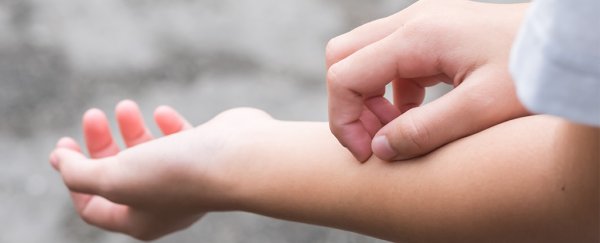Much like yawning, scratching can be a contagious behaviour, set off simply by watching another person relieve an itch.
Scientists have now found that mice share the same response, and the discovery could help us identify the brain circuitry responsible for causing us to feel another's irritation.
Previous research on socially contagious behaviours has both supported and rejected the idea that feeling a need to yawn or scratch when others do is linked to our sense of empathy, leaving the cause behind such an innate urge unexplained.
Scientists from the awesomely named Centre for the Study of Itch at Washington University figured it would be easier to study the faithful old lab mouse rather than primates, but only if the rodent shared our urge to scratch along with a friend.
Their first step was to put a pair of mice into neighbouring containers and analyse their behaviour. All signs indicated that if one mouse scratched, the other was statistically more likely to do so as well.
To ensure this reaction was purely based on visual perception, they repeated the experiment using a mouse on a video screen, to much the same effect.
"Within a few seconds, the mouse in the enclosure would start scratching, too," said researcher Zhou-Feng Chen.
"This was very surprising because mice are known for their poor vision. They use smell and touch to explore areas, so we didn't know whether a mouse would notice a video. Not only did it see the video, it could tell that the mouse in the video was scratching."
Since earlier studies had shown that mice only demonstrate empathy with individuals they know, the fact that the mouse on the screen was a stranger indicated in this particular case, empathy had nothing to do with their need to scratch.
Brain scans on the mice that watched others scratch revealed that a region in their hypothalamus called the suprachiasmatic nucleus (SCN) would light up during moments when they mirrored the other mouse's scratching.
Usually this part of the brain would control circadian rhythms, using light signals detected by the eyes to determine when the mouse should feel sleepy or when it should be awake each day.
"Because the SCN receives visual input directly or indirectly, we hypothesised that it could be one of the first relay circuits for mediating contagious itch behaviour," the researchers wrote in their paper.
To communicate, nerves in the SCN use a protein-like molecule called gastrin-releasing peptide (GRP) – a compound that Chen and his team identified in 2007 as a key messenger of itch signals between the skin and the spinal cord.
When GRP was blocked in the brain, the mice stopped scratching when they watched other mice scratch, even if their skin could still potentially feel itchy.
On the other hand, injecting GRP directly into their brains while using electrodes to stimulate the SCN caused them to scratch frantically.
"The mouse doesn't see another mouse scratching and then think it might need to scratch, too," Chen said. "Instead, its brain begins sending out itch signals using GRP as a messenger."
In the future, the team hopes to analyse the exact neural circuits involved, and figure out exactly how an image triggers an innate response.
It's not clear if the exact same pathway exists in humans, but according to Chen, it's a fair bet that not only do we have something like it, but other socially contagious mechanisms could also share similar mechanisms.
Knowing how our brain functions doesn't tell us a great deal how these behaviours have benefited us, but it's possible that we evolved these traits so that actions taken by one member of our group could give another member a head start.
Scratching before that parasite bites or yawning before your brain overheats could transfer an advantage within a social group.
One thing's for sure – even just by reading this article, there's a good chance you've already scratched yourself at least once. Okay, make that twice.
This research was published in Science.
